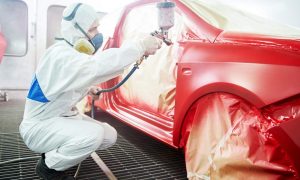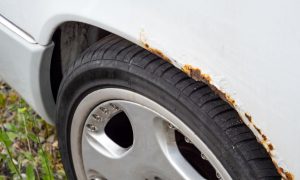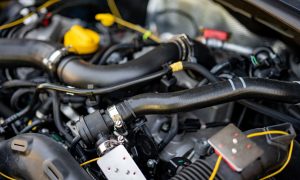You’ve repaired the dents. The bodywork looks solid. But now comes a tricky part—choosing the right paint color. Getting the paint color right after a collision is more than cosmetic. It directly affects the car’s resale value and your satisfaction. A perfect match makes the vehicle look untouched. A mismatch? That just screams “repaired,” even from across the street.
Today, color matching has become more precise thanks to technology and expert technicians. But there’s still a lot to consider—paint codes, fading, application methods, and the right tools. One wrong step, and you’re looking at patchy panels or uneven shades.
So, how do you find the perfect match? Let’s get into the key steps.
Identify Your Car’s Paint Code

The first step in achieving a perfect color match is finding your car’s paint code.
Every vehicle comes with a factory-issued color code. It’s a unique identifier that auto paint professionals use to mix your original color formula. You’ll typically find the code on a label in places like the door jamb, glove box, or under the hood. If not, your car’s manual or the manufacturer’s website can help.
This code takes the guesswork out of the process. Rather than relying on your memory or a visual guess, the code ensures you’re starting with the right base. Many car manufacturers even have databases that include layers like pearl coats, metallic flakes, and clear coats.
Even two “black” cars might have different codes—one may lean toward blue undertones while another has red hints. The code ensures you use the right version for your model and year.
Consider Professional Color Matching Services
Now that you’ve got the code, it might be tempting to DIY the process. But hold up—paint color isn’t just about slapping on a matching hue.
Professional color matching services use tools like spectrophotometers, digital color-matching systems, and computerized paint-matching programs. These tools read your car’s current paint under specific lighting conditions and calculate the exact blend needed. This matters because cars fade over time, even if you don’t notice it.
Shops like Miracle Body and Paint or Certified Collision Centers don’t just rely on the original color formula. They compare your current paint’s condition with the factory shade. Then they adjust the mix accordingly. The result? A finish that blends perfectly across panels.
Plus, professionals know how to apply the paint properly. They understand spray angle, temperature, and nozzle size—little things that make a big difference.
Use OEM Paints
OEM stands for Original Equipment Manufacturer. In the world of auto paint, that means using paints approved by the car’s maker.
These paints are made using the same ingredients and formulas as the factory used. They have better consistency and are more likely to match your car’s tone, texture, and finish. Aftermarket paints might look similar at first but could fade differently or reflect light in an odd way over time.
OEM paints also maintain the integrity of your car’s warranty. If you’re working with a dealership or insurance claim, using non-OEM paint might void coverage.
Think of OEM paint as an investment. You pay a little more upfront, but you’re buying peace of mind and long-term color accuracy.
Check for Fading and Aging
Paint doesn’t stay the same forever. Even if you park your car indoors, UV exposure slowly alters the color.
This is why relying solely on the paint code isn’t always enough. The original formula reflects how the paint looked when the car was new. But after three, five, or ten years? The pigment and clear coat have probably changed.
That’s why professionals always compare real-time color samples with the factory code. They may use blending techniques to gradually merge new and old paint across panels. This prevents any harsh contrast between old and new finishes.
Cars exposed to harsh climates or lots of sun might show more noticeable aging. In those cases, it’s important to adjust for those conditions before applying fresh paint.
Test the Color Before Applying
Before applying any paint to your car, you must test it first.
A test panel or spray-out card lets you see how the color behaves in real-world lighting. Natural sunlight, fluorescent garage lights, and shadows can all change how a color looks. What seemed like a match indoors could look wildly different outside.
Testing also shows how the paint settles, dries, and reflects light. For finishes with metallic or pearlescent flakes, application angle matters. You want to confirm consistency before committing to the full surface.
Some shops place test panels beside the existing panel to compare under identical light. If the match isn’t perfect, they tweak the mix, test again, and only proceed once they’re confident.
Skipping this step can result in costly do-overs. Or worse—living with a mismatched door that never quite looks right.
Seek Professional Advice
Not everyone has the eye for color. Even fewer have the tools or experience to get it exactly right.
A skilled technician can guide you through this process. They’ll know what blend works best for your car’s make, model, and age. They’ll also suggest the right type of paint—metallic, flat, pearl, or gloss—based on what was used originally.
In some cases, they might even recommend repainting adjacent panels. This isn’t upselling—it’s a way to ensure the new paint blends in seamlessly. Paint doesn’t end at the edge of a fender. It flows, catches light, and reflects based on nearby surfaces.
If you’re unsure whether to go DIY or hire help, here’s a hint: if your car has a complex finish, go pro.
A Quick Personal Note
Years ago, I took my aging sedan to a body shop after a minor accident. I figured I’d save money by touching up the paint myself. I used the factory code, bought matching paint from an auto parts store, and went to work in my garage.
Big mistake.
The panel came out two shades lighter. The finish looked uneven under sunlight. And worst of all, I ended up paying a pro to fix my attempt.
Lesson? Don’t skimp on expert advice or proper testing. Matching paint isn’t just about color—it’s about process, patience, and precision.
Conclusion
Choosing the right paint color after a collision repair isn’t just about looks. It’s about preserving value, restoring quality, and doing the job right.
Start with your vehicle’s paint code. Don’t ignore aging or fading. Use OEM paint whenever possible. And above all, test before you commit.
If you’re unsure, consult a pro. They’ll make sure your car doesn’t just get repaired—but looks as good as new.
Because nothing ruins a sleek repair like mismatched paint.
Also Read: What is an Anti-Perforation Warranty?
FAQs
It’s a unique identifier for your car’s paint. Look inside the door jamb or under the hood.
Your original paint may have faded. A simple can might not match the current shade.
Yes. It ensures accuracy, a seamless blend, and protects resale value.
OEM paint matches factory specs exactly. Aftermarket paint may differ in tone, finish, or durability.




